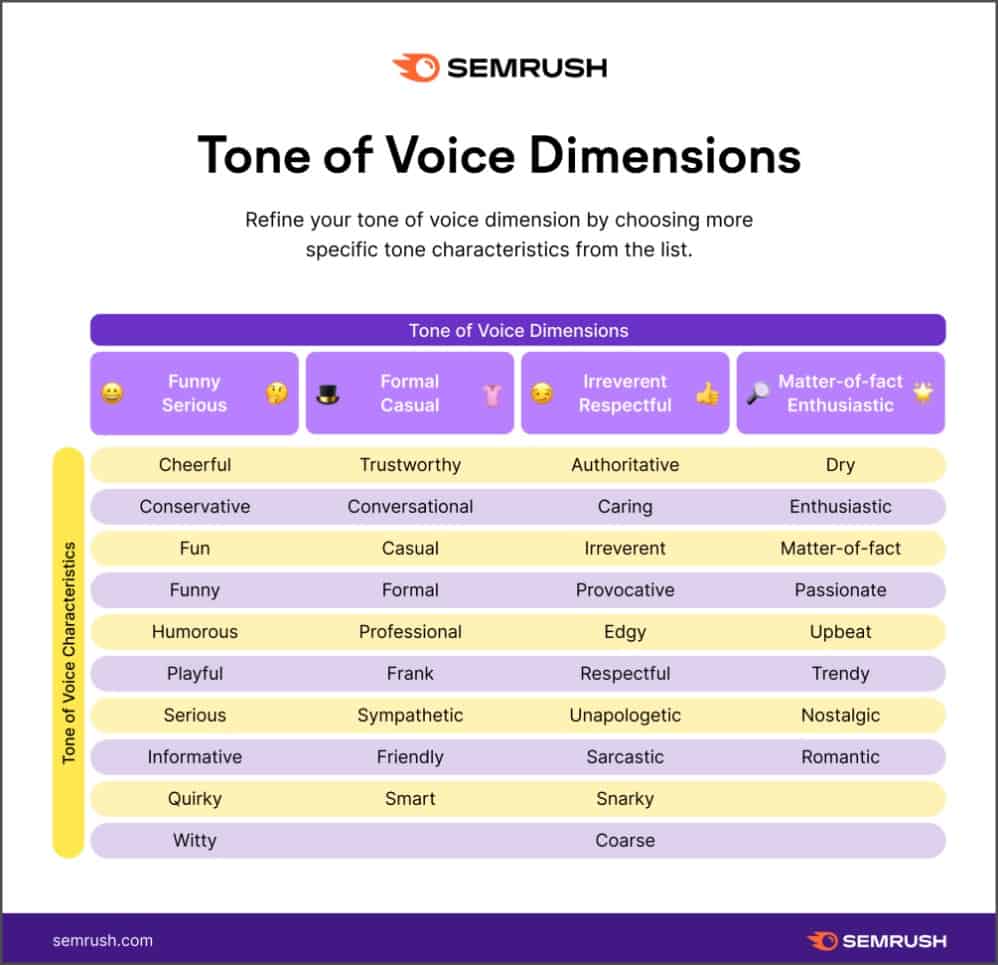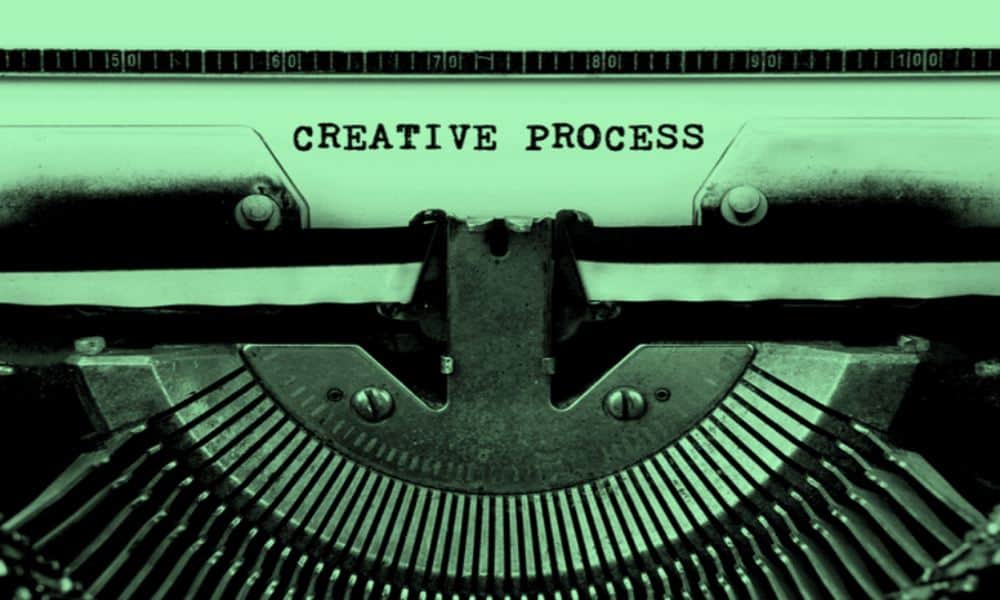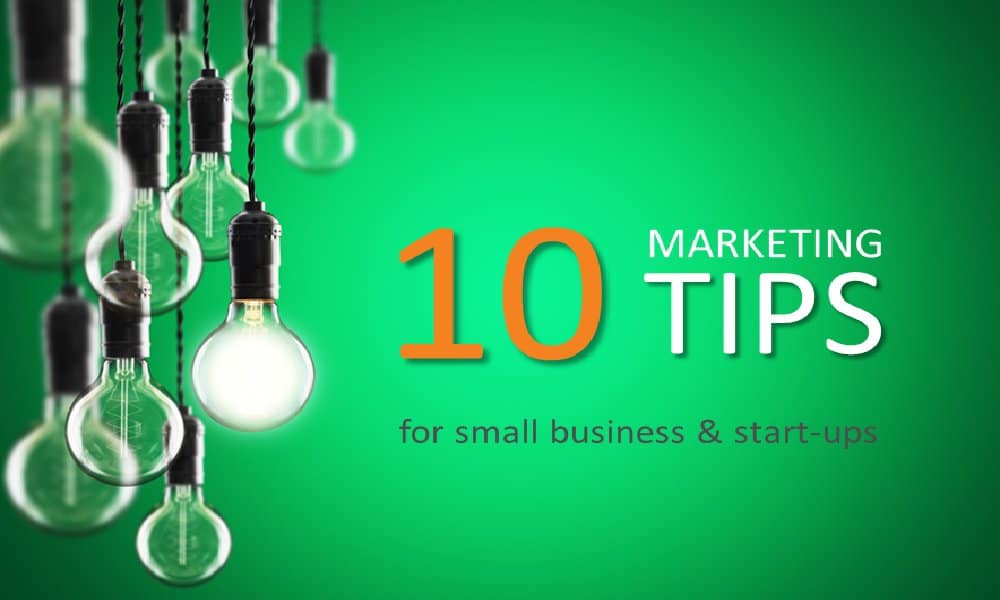We all know what brand is – or we all think we do. But many business owners stop at brand visual identity – logo, colours, font and possibly even image guidelines. They’re missing two vital elements – the brand voice and the brand experience. As a copywriter, I’m primarily concerned with your brand voice, and that’s what we’re looking at in this post.
What is brand voice?
Where your brand visual identity is what your brand looks like, brand voice is more about what you say and how you say it. To round off the picture, brand experience is what you do and how you do it – the moment(s) of truth when clients interact with you.
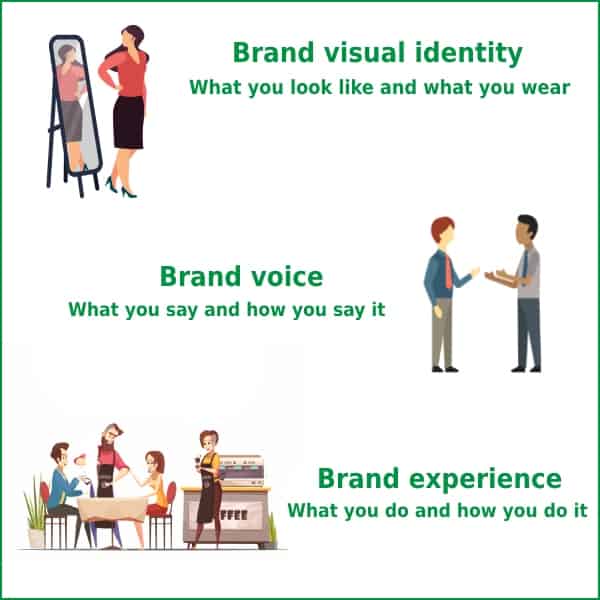
Why does brand voice matter?
There are two key reasons brand voice is important.
Your brand voice can help you stand out in the market
Examples include businesses in traditionally conservative sectors who take a different approach.
Mailchimp is a great example. Most email marketing platforms (most software services) are formal and businesslike. Mailchimp is informal and amusing. It’s not just in the images, which have changed over time. It’s in the words which go with them. Look at the line of text in the image below. ‘Keep pushing forward. We’ve got your back.’ It’s all about easy support and cheering you on.
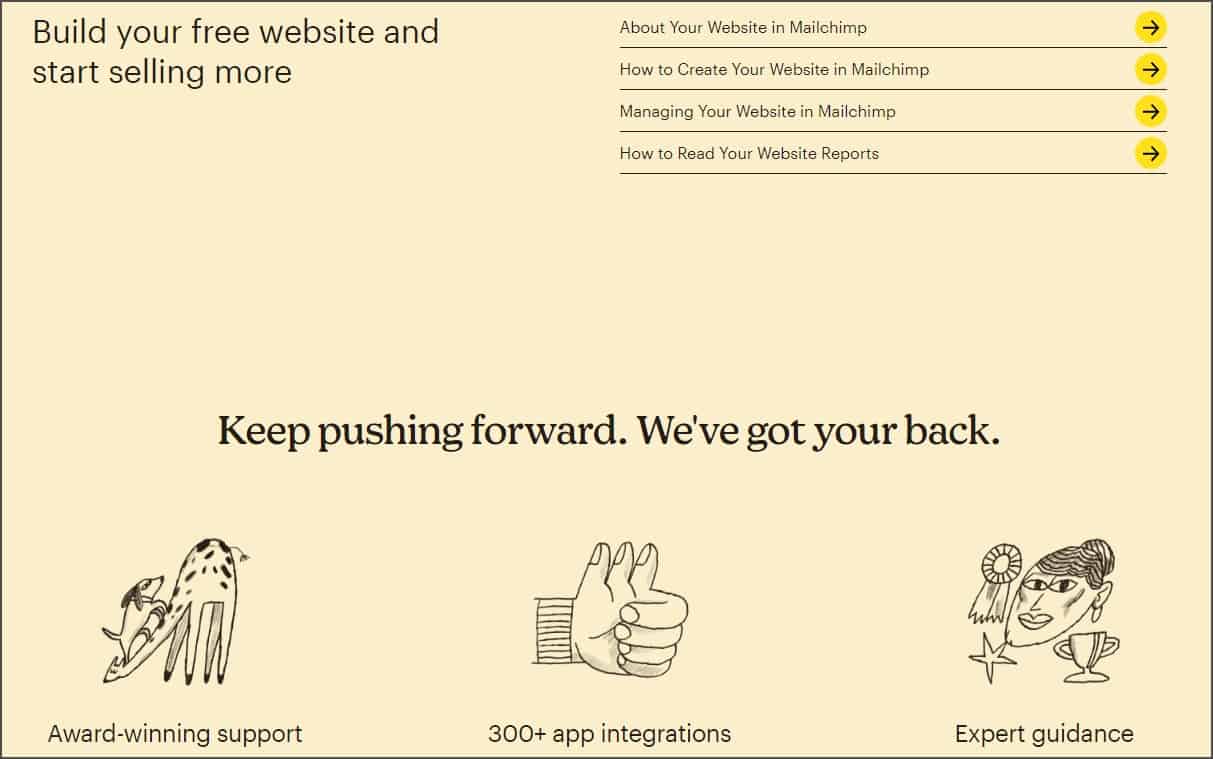
It builds recognition and trust
Even if your brand voice doesn’t stand out in this way, it can (should!) be consistent wherever people interact with you. Consistency builds trust.
We’ve all met at least one person whose tone and manner changes depending on who else is in the room. We’ve probably met someone whose opinions change depending on who they’re talking to. Those people are harder to trust. Exactly the same thing happens with your brand voice.
There will of course be some changes in tone and language depending on the specific subject. If you’re discussing a price rise or a product discontinuation, you won’t sound exactly the same as you do when launching a special promotion. But you do want to sound basically the same.
That consistency adds to your credibility and enables potential clients to trust you. That’s what you’re looking for.
Defining your brand voice
Whether you’ve been thinking about it or not, you already have a brand voice. It may, or may not, be what you’d like it to be. Here are some pointers to help you understand your current brand voice. They can also help you define it in a way which helps you communicate with others.
1. Align your brand voice with your own personality
Think of Richard Branson and the cheeky, irreverent tone which is there across all the Virgin businesses. More locally, Gerry Harvey of Harvey Norman has a distinct personality. His outspoken go-getter style and focus on competitive pricing are reflected in the store’s ads.
On the other hand, how much do you know about the personality of the leadership at Telstra, Seek or Bunnings?
Big businesses can lean in to the founder’s personality or not as they choose. If you’re a small business, you have fewer options. Most of your clients and prospects will end up interacting with you. If the image the business projects doesn’t match, you risk damaging credibility and trust. You don’t need a 100% correlation, but you do want alignment. If you’re informal and chatty, keep your website that way too. If you focus on quality over cost or timeliness, express that.
2. Align with your market
Who are you trying to connect with? Are they up to date with fashion, trends and pop culture? Would they understand references to Netflix shows? Or should you reference stories from the business news? What kinds of words and shorthand references do they use? What’s their sense of humour?
You’ll probably find there are similarities between your personality and that of your favourite clients. Emphasise those to build connection.
3. Find existing content which resonates
Unless you’re a brand new business, you have some kind of content. A brochure. A website. A blog. Some social media accounts. Which pieces of content resonate most with your contacts and clients?
For web content, look at your Google Analytics account and find the pages which have high visits, long dwell times and low bounce rates. For social content, look for posts which are liked, shared and commented on. You’ll get some ideas about what people like in your existing voice. Use that to double down on the positives.
4. Brand Archetypes
Brand archetypes are a little like the Zodiac of branding. There are 12 overarching archetypes based on different personalities: the innocent, the everyman, the hero, the outlaw, the explorer, the creator, the ruler, the magician, the lover, the caregiver, the jester and the sage.
Of course this is simplistic, but looking into your brand archetype can help you understand your overall positioning – which in turn affects your brand voice. Jesters, leaders and caregivers use very different language to generate different emotional impacts. Of course, classifying all brands and businesses into just 12 types is simplistic. That’s why I like this brand archetype quiz which identifies your top three archetypes rather than sticking you in one box. Use these as a basis to think about what you’d like to emphasise or downplay.
5. Who do you aspire to be?
Ask yourself, or brainstorm with your team:
- Which celebrity or notable figure embodies your brand?
- Which other brands do you admire and wish you could be like?
Now try to work out what exactly it is about the person or brand which you identify with.
6. Brand adjectives or characteristics
Once you have an idea of your archetype or overall positioning, narrow it down and personalise it by picking just three adjectives to describe your brand. For example, both ‘expert‘ and ‘clever‘ relate to the ‘Sage’ archetype, but ‘expert‘ suggests knowledge in one or more areas, whereas ‘clever‘ suggests learning, adaptability and innovation, so also relates to the ‘Creator’ archetype.
This example list from Semrush is focused on adjectives which can be used to refine your desired tone of voice.
Or you could pick and choose from this much longer list:
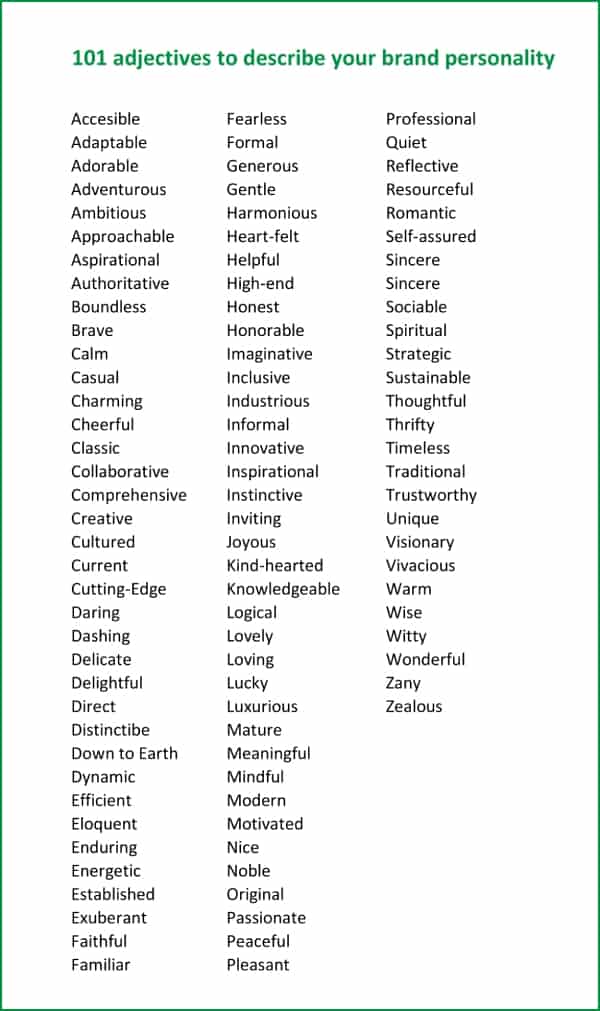
Another way of using adjectives is to think about what how you don’t want people to perceive you. We’re not condescending. We’re not bossy. We’re not silly.
We’re X but not Y
Combining positive and negative adjectives can give some very clear guidelines. Here’s what Slack came up with.
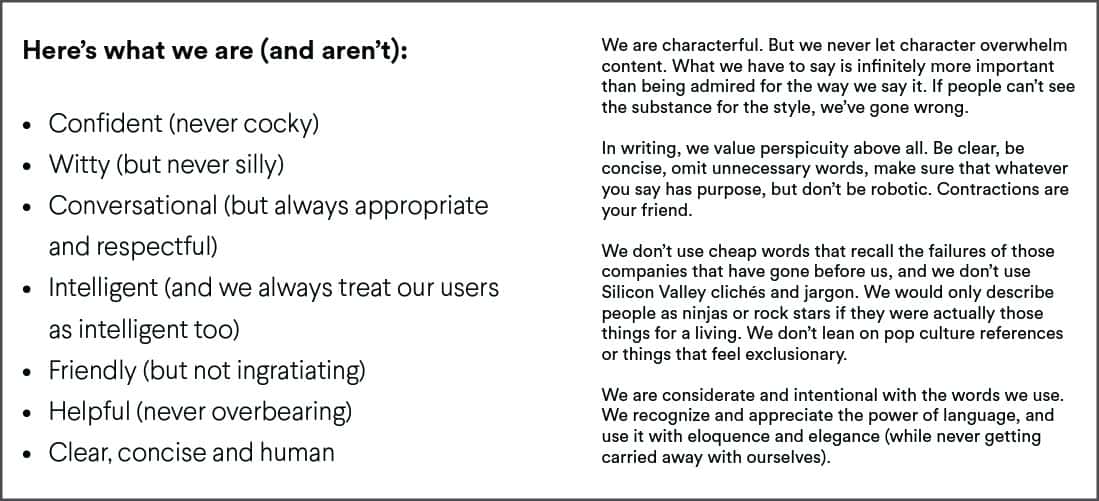
Sliding scales
Yet another way of looking at brand adjectives is to decide where you sit on a sliding scale between two opposite characteristics. Note that these characteristics are not positive or negative in themselves, but they do help you distinguish what you’re like.
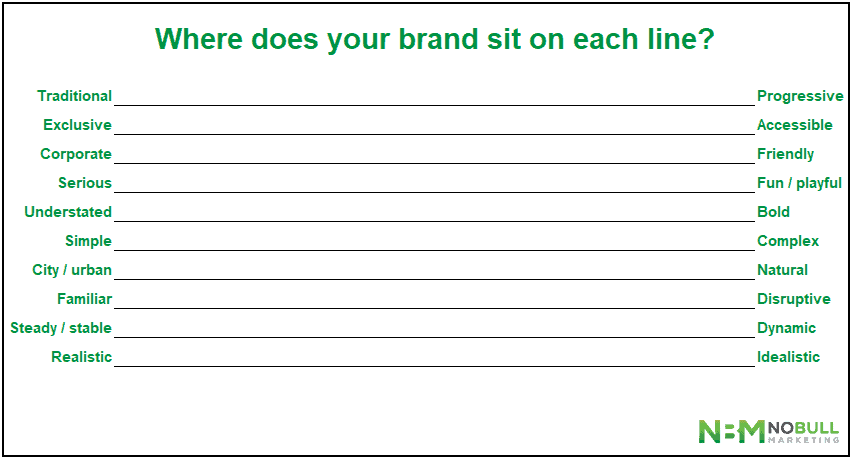
Creating brand voice guidelines
It’s great to spend time working out how you want to present – but unless you can communicate that clearly to everyone who’s writing for you, it doesn’t help.
Once you have clarity, formalise it in a one page document, or as part of your brand style guide. Then use it!
- Share it with your team. Everyone who works for you and interacts with clients or potential clients should know what the guidelines are, whether they’re writing copy or not.
- Share it with external suppliers.
- Use it to review any drafts submitted to you. It will help you explain to the writer what and why you need changes.
Final advice: keep it simple
This may sound like an awful lot of work to define your brand voice. It doesn’t have to be. You don’t have to do all the exercises – pick one or two which you like the sound of. You don’t have to involve your entire team. A very simple option is just to pick 3 or 4 adjectives. That one action will make it easier for a writer to capture the brand voice you want.
Many of our clients don’t even do that. But because our process involves interviewing you and capturing your words, we usually get very close to brand voice in the first draft. We use your words and your phrases so that your copy is consistent – consistent over time and consistent with you. So if you’re looking for a strong, consistent brand voice in your copy, let’s chat!


